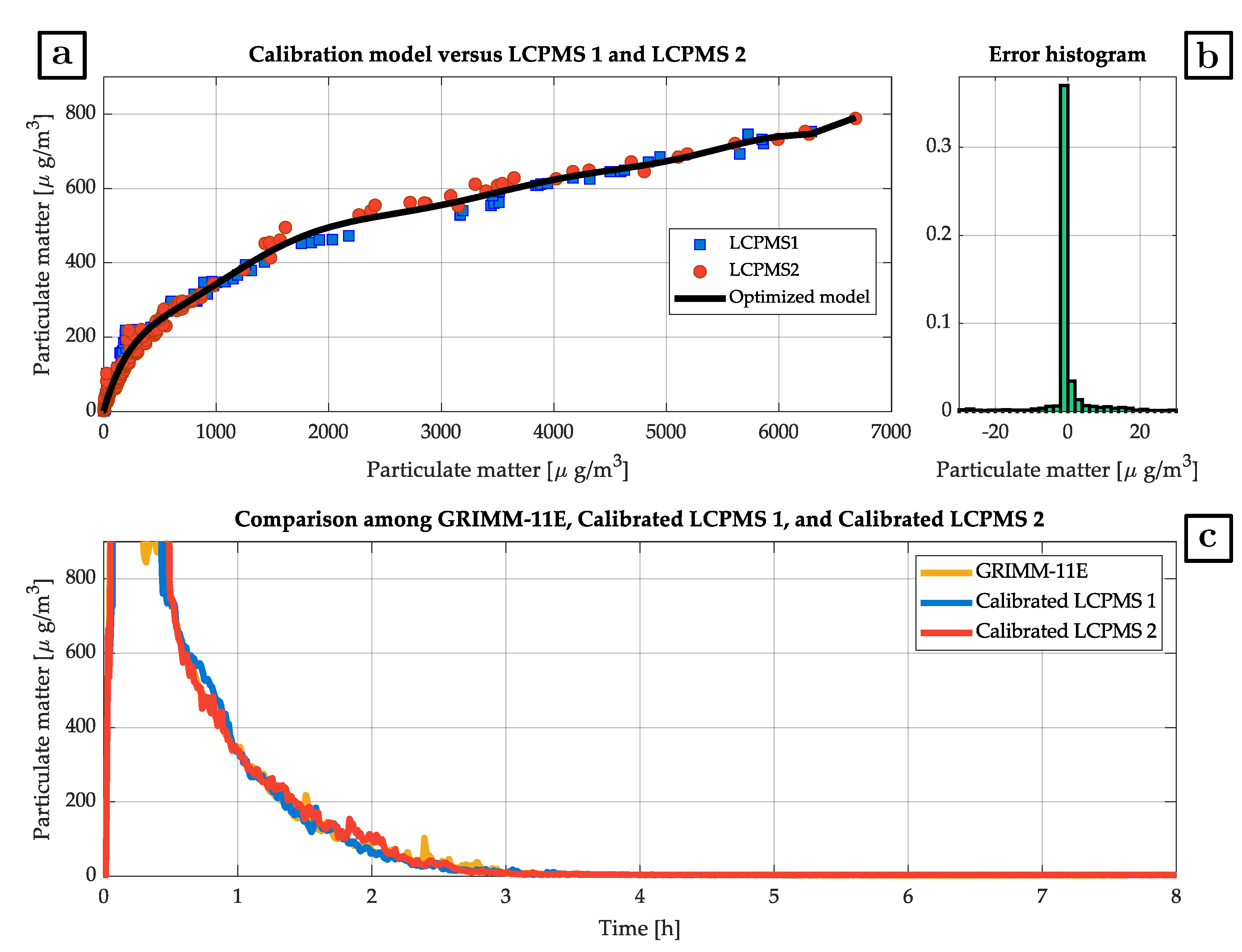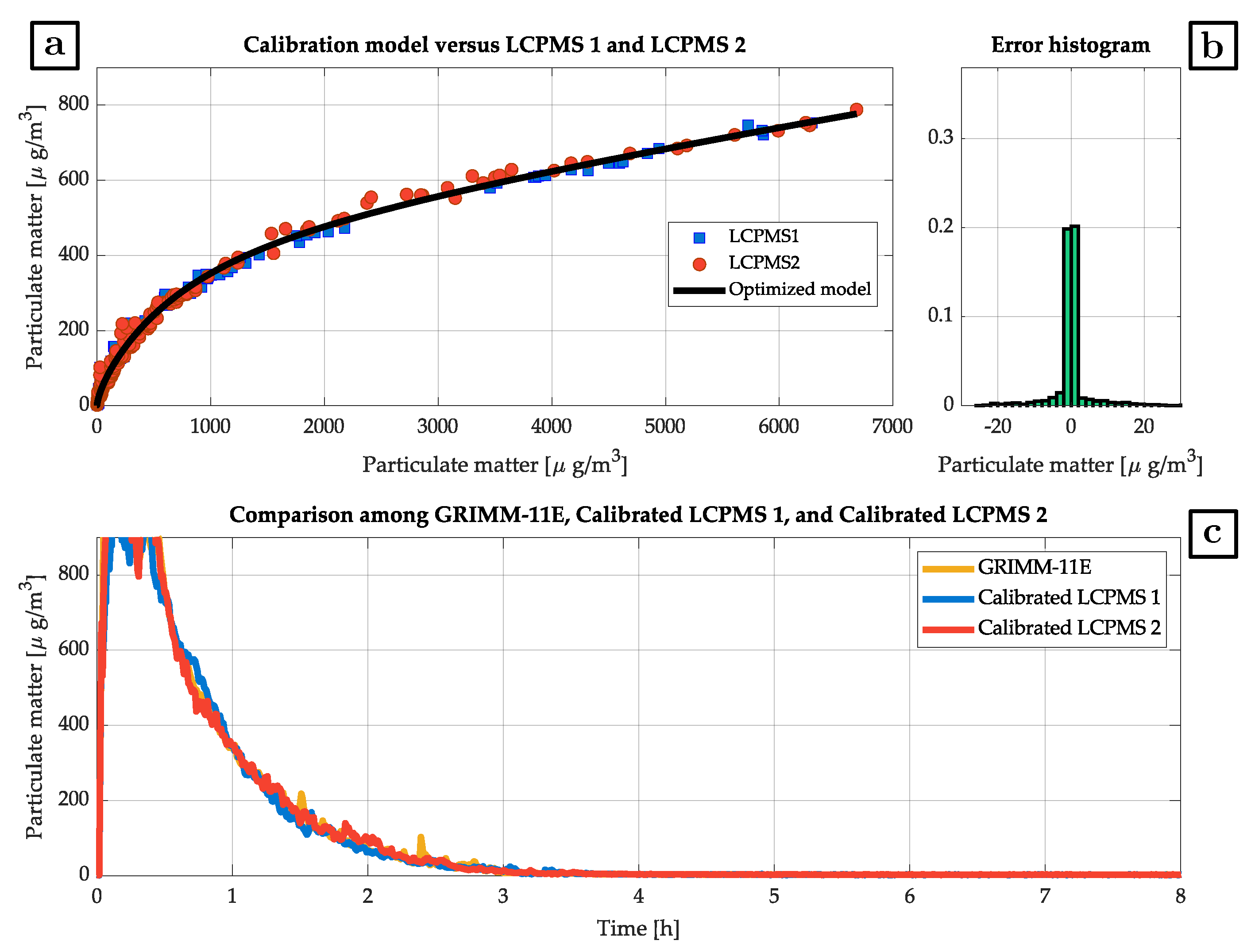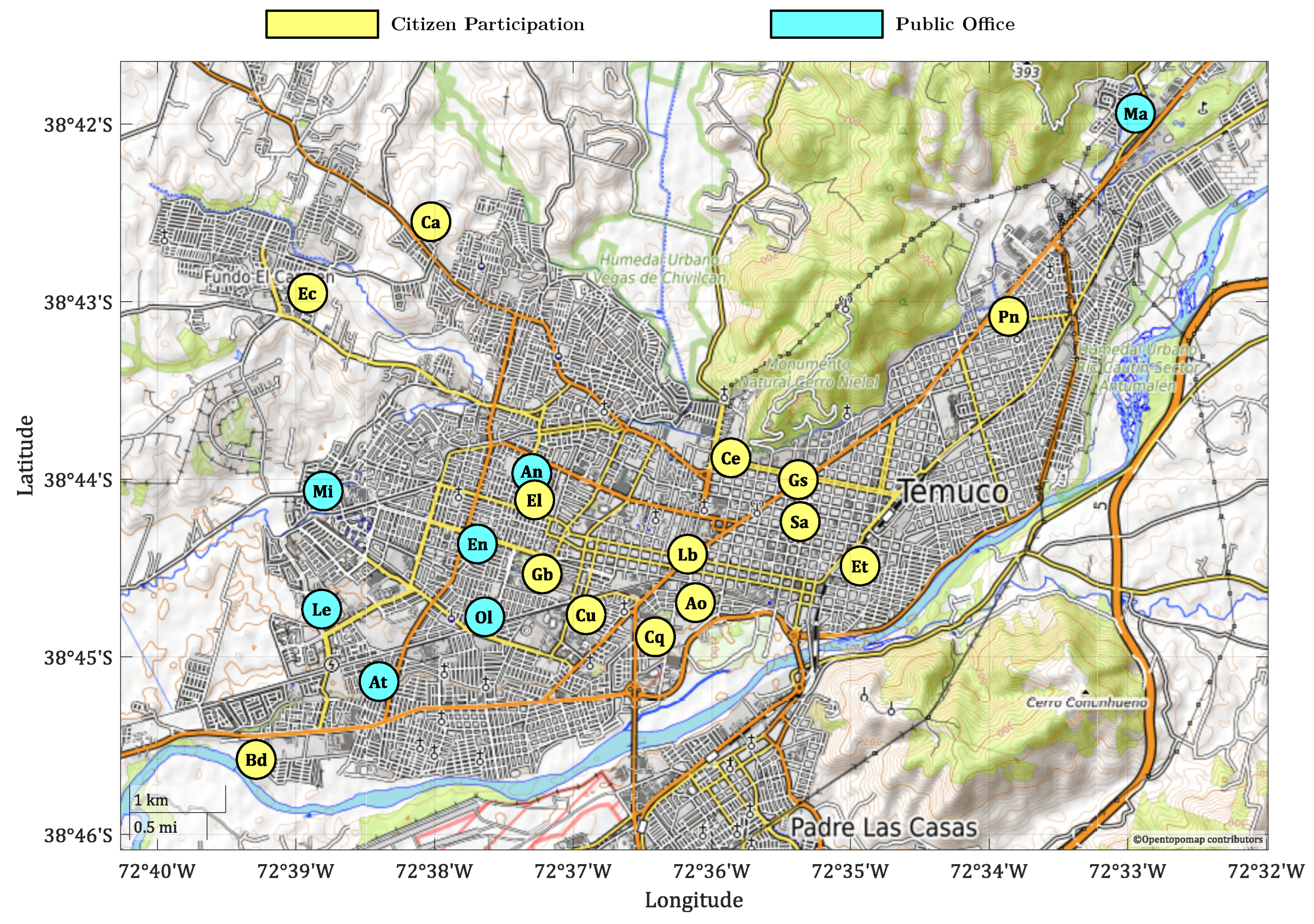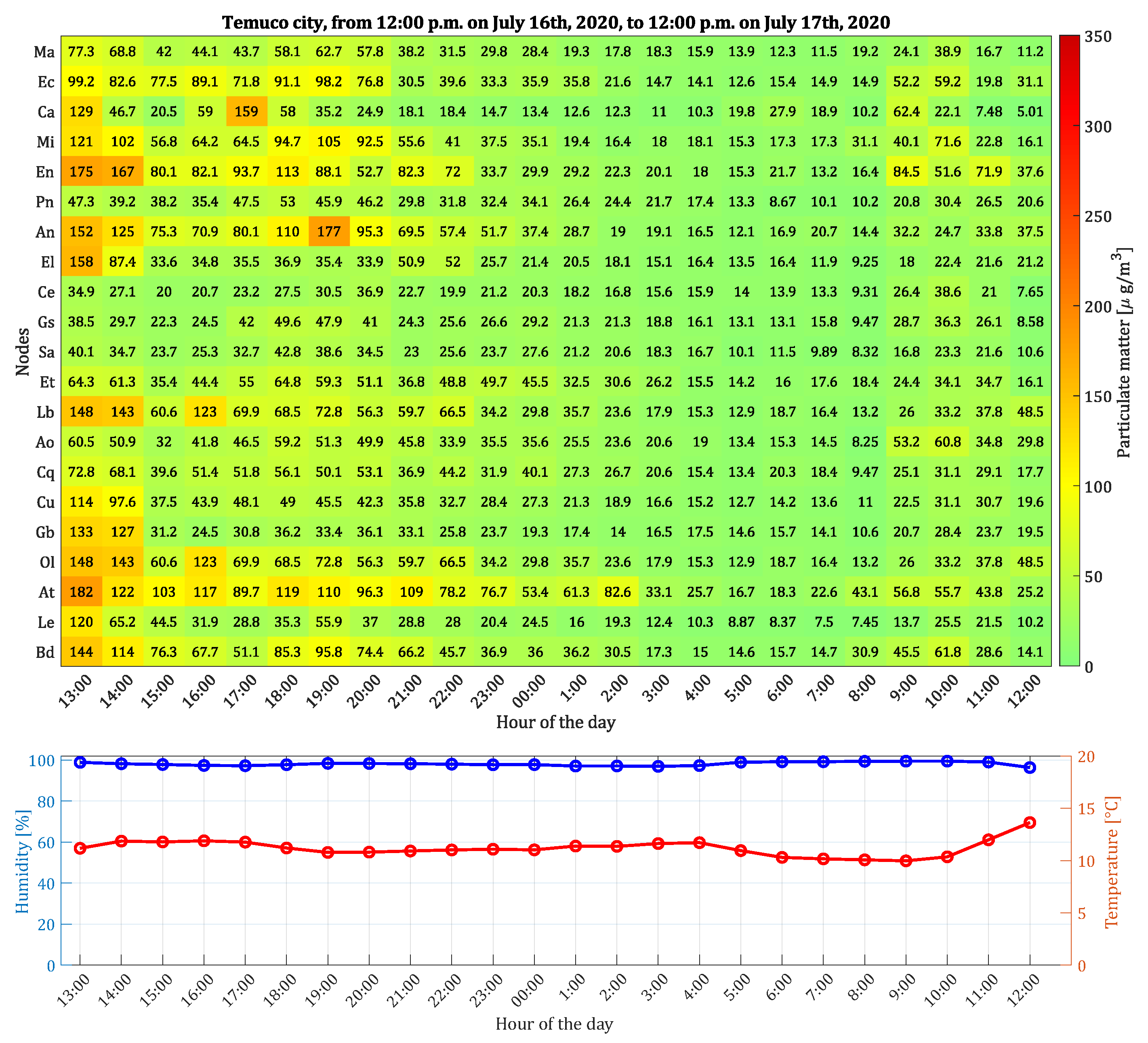Calibration of Sensor Network for Outdoor Measurement of PM2.5 on High Wood-Heating Smoke in Temuco City
Abstract
1. Introduction
2. Methods
2.1. Particulate Matter IoT Devices
2.2. Reference Instrument
3. Sensor-Node Calibration
3.1. Polynomial Calibration Model
3.2. Nonlinear Function Calibration Model
4. Case Study: IoT Network for Particle-Size Monitoring in Temuco City
4.1. Comparison of the LCPM with Other Solutions
4.2. Node-Deployment Criteria
4.3. Results of Three Consecutive Days
5. Discussion and Conclusions
Author Contributions
Funding
Acknowledgments
Conflicts of Interest
References
- Jorquera, H.; Barraza, F.; Heyer, J.; Valdivia, G.; Schiappacasse, L.N.; Montoya, L.D. Indoor PM2.5 in an urban zone with heavy wood smoke pollution: The case of Temuco, Chile. Environ. Pollut. 2018, 236, 477–487. [Google Scholar] [CrossRef] [PubMed]
- Quinteros, M.E.; Lu, S.; Blazquez, C.; Cárdenas-R, J.P.; Ossa, X.; Delgado-Saborit, J.M.; Harrison, R.M.; Ruiz-Rudolph, P. Use of Data Imputation Tools to Reconstruct Incomplete Air Quality Datasets: A Case-Study in Temuco, Chile; Elsevier Ltd.: Amsterdam, The Netherlands, 2019; Volume 200, pp. 40–49. [Google Scholar] [CrossRef]
- Mardones, C.; Cornejo, N. Ex-post evaluation of a program to reduce critical episodes due to air pollution in southern Chile. Environ. Impact Assess. Rev. 2020, 80, 106334. [Google Scholar] [CrossRef]
- Boso, A.; Álvarez, B.; Oltra, C.; Garrido, J.; Muñoz, C.; Hofflinger, A. Out of sight, out of mind: Participatory sensing for monitoring indoor air quality. Environ. Monit. Assess. 2020, 192, 1–15. [Google Scholar] [CrossRef] [PubMed]
- Ministerio_del_Medio_Ambiente_de_Chile. Sistema de Información Nacional de Calidad del Aire Home Page. 2020. Available online: https://sinca.mma.gob.cl/index.php/ (accessed on 16 April 2023).
- Becnel, T.; Tingey, K.; Whitaker, J.; Sayahi, T.; Le, K.; Goffin, P.; Butterfield, A.; Kelly, K.; Gaillardon, P.E. A Distributed Low-Cost Pollution Monitoring Platform. IEEE Internet Things J. 2019, 6, 10738–10748. [Google Scholar] [CrossRef]
- Johnston, S.J.; Basford, P.J.; Bulot, F.M.; Apetroaie-Cristea, M.; Easton, N.H.; Davenport, C.; Foster, G.L.; Loxham, M.; Morris, A.K.; Cox, S.J. City scale particulate matter monitoring using LoRaWAN based air quality IoT devices. Sensors 2019, 19, 209. [Google Scholar] [CrossRef]
- Alfano, B.; Barretta, L.; Giudice, A.D.; De Vito, S.; Francia, G.D.; Esposito, E.; Formisano, F.; Massera, E.; Miglietta, M.L.; Polichetti, T. A review of low-cost particulate matter sensors from the developers’ perspectives. Sensors 2020, 20, 6819. [Google Scholar] [CrossRef]
- Levy Zamora, M.; Xiong, F.; Gentner, D.; Kerkez, B.; Kohrman-Glaser, J.; Koehler, K. Field and Laboratory Evaluations of the Low-Cost Plantower Particulate Matter Sensor. Environ. Sci. Technol. 2019, 53, 838–849. [Google Scholar] [CrossRef]
- Johnston, S.J.; Basford, P.J.; Bulot, F.M.; Apetroaie-Cristea, M.; Fosterx, G.L.; Loxhamz, M.; Cox, S.J. IoT deployment for city scale air quality monitoring with Low-Power Wide Area Networks. In Proceedings of the 2018 Global Internet of Things Summit, GIoTS 2018, Bilbao, Spain, 4–7 June 2018. [Google Scholar] [CrossRef]
- Sayahi, T.; Butterfield, A.; Kelly, K.E. Long-term field evaluation of the Plantower PMS low-cost particulate matter sensors. Environ. Pollut. 2019, 245, 932–940. [Google Scholar] [CrossRef]
- Badura, M.; Sówka, I.; Szymański, P.; Batog, P. Assessing the usefulness of dense sensor network for PM2.5 monitoring on an academic campus area. Sci. Total. Environ. 2020, 722, 137867. [Google Scholar] [CrossRef]
- Tagle, M.; Rojas, F.; Reyes, F.; Vasquez, Y.; Hallgren, F.; Linden, J.; Kolev, D.; Watne, A.K.; Oyola, P. Field performance of a low-cost sensor in the monitoring of particulate matter in Santiago, Chile. Environ. Monit. Assess. 2020, 192, 171. [Google Scholar] [CrossRef]
- Ferrer-Cid, P.; Barcelo-Ordinas, J.M.; Garcia-Vidal, J.; Ripoll, A.; Viana, M. Multisensor Data Fusion Calibration in IoT Air Pollution Platforms. IEEE Internet Things J. 2020, 7, 3124–3132. [Google Scholar] [CrossRef]
- Papapostolou, V.; Zhang, H.; Feenstra, B.J.; Polidori, A. Development of an environmental chamber for evaluating the performance of low-cost air quality sensors under controlled conditions. Atmos. Environ. 2017, 171, 82–90. [Google Scholar] [CrossRef]
- Sayahi, T.; Kaufman, D.; Becnel, T.; Kaur, K.; Butterfield, A.E.; Collingwood, S.; Zhang, Y.; Gaillardon, P.E.; Kelly, K.E. Development of a calibration chamber to evaluate the performance of low-cost particulate matter sensors. Environ. Pollut. 2019, 255, 113131. [Google Scholar] [CrossRef] [PubMed]
- Malings, C.; Tanzer, R.; Hauryliuk, A.; Saha, P.K.; Robinson, A.L.; Presto, A.A.; Subramanian, R. Fine particle mass monitoring with low-cost sensors: Corrections and long-term performance evaluation. Aerosol Sci. Technol. 2020, 54, 160–174. [Google Scholar] [CrossRef]
- Magi, B.I.; Cupini, C.; Francis, J.; Green, M.; Hauser, C. Evaluation of PM2.5 measured in an urban setting using a low-cost optical particle counter and a Federal Equivalent Method Beta Attenuation Monitor. Aerosol Sci. Technol. 2020, 54, 147–159. [Google Scholar] [CrossRef]
- Zaidan, M.A.; Motlagh, N.H.; Fung, P.L.; Lu, D.; Timonen, H.; Kuula, J.; Niemi, J.V.; Tarkoma, S.; Pet, T. Intelligent Calibration and Virtual Sensing for Integrated Low-Cost Air Quality Sensors. IEEE Sens. J. 2020, 1, 15. [Google Scholar] [CrossRef]
- Datta, A.; Saha, A.; Zamora, M.L.; Buehler, C.; Hao, L.; Xiong, F.; Gentner, D.R.; Koehler, K. Statistical field calibration of a low-cost PM2.5 monitoring network in Baltimore. Atmos. Environ. 2020, 242, 117761. [Google Scholar] [CrossRef]
- Schneider, P.; Castell, N.; Vogt, M.; Dauge, F.R.; Lahoz, W.A.; Bartonova, A. Mapping urban air quality in near real-time using observations from low-cost sensors and model information. Environ. Int. 2017, 106, 234–247. [Google Scholar] [CrossRef]
- Liu, H.Y.; Schneider, P.; Haugen, R.; Vogt, M. Performance assessment of a low-cost PM 2.5 sensor for a near four-month period in Oslo, Norway. Atmosphere 2019, 10, 41. [Google Scholar] [CrossRef]
- Cao, R.; Li, B.; Wang, Z.; Peng, Z.R.; Tao, S.; Lou, S. Using a distributed air sensor network to investigate the spatiotemporal patterns of PM2.5 concentrations. Environ. Pollut. 2020, 264, 114549. [Google Scholar] [CrossRef]
- Blanco, E.; Rubilar, F.; Quinteros, M.E.; Cayupi, K.; Ayala, S.; Lu, S.; Jimenez, R.B.; Cárdenas, J.P.; Blazquez, C.A.; Delgado-Saborit, J.M.; et al. Spatial distribution of particulate matter on winter nights in Temuco, Chile: Studying the impact of residential wood-burning using mobile monitoring. Atmos. Environ. 2022, 286, 119255. [Google Scholar] [CrossRef]
- Quinteros, M.E.; Blanco, E.; Sanabria, J.; Rosas-Diaz, F.; Blazquez, C.A.; Ayala, S.; Cárdenas-R, J.P.; Stone, E.A.; Sybesma, K.; Delgado-Saborit, J.M.; et al. Spatio-temporal distribution of particulate matter and wood-smoke tracers in Temuco, Chile: A city heavily impacted by residential wood-burning. Atmos. Environ. 2023, 294, 119529. [Google Scholar] [CrossRef]
- Bulot, F.M.J.; Russell, H.S.; Rezaei, M.; Johnson, M.S.; Ossont, S.J.J.; Morris, A.K.R.; Basford, P.J.; Easton, N.H.C.; Foster, G.L.; Loxham, M.; et al. Laboratory comparison of low-cost particulate matter sensors to measure transient events of pollution. Sensors 2020, 20, 2219. [Google Scholar] [CrossRef]
- Sensirion - Particulate Matter Sensor SPS30 Home Page. Available online: https://sensirion.com/products/catalog/SEK-SPS30 (accessed on 28 June 2023).
- Reyes, F.; Ahumada, S.; Rojas, F.; Oyola, P.; Vásquez, Y.; Aguilera, C.; Henriquez, A.; Gramsch, E.; Kang, C.M.; Saarikoski, S.; et al. Impact of biomass burning on air quality in Temuco city, chile. Aerosol Air Qual. Res. 2021, 21, 210110. [Google Scholar] [CrossRef]
- European Standard, E. Ambient Air: Standard Gravimetric Measurement Method for the Determination of the PM10 or PM2.5 Mass Concentration of Suspended Particulate Matter. 2014. Available online: https://www.en-standard.eu/bs-en-12341-2014-ambient-air-standard-gravimetric-measurement-method-for-the-determination-of-the-pm-sub-10-sub-or-pm-sub-2-sub-d-sub-5-sub-mass-concentration-of-suspended-particulate-matter/ (accessed on 28 June 2023).
- European Standard, B.E. Ambient Air Quality. Standard Gravimetric Measurement Method for the Determination of the PM2.5 Mass Fraction of Suspended Particulate Matter. 2005. Available online: https://www.une.org/encuentra-tu-norma/busca-tu-norma/norma?c=N0036322 (accessed on 28 June 2023).
- Coleman, J.R.; Meggers, F. Sensing of indoor air quality—characterization of spatial and temporal pollutant evolution through distributed sensing. Front. Built Environ. 2018, 4, 1–12. [Google Scholar] [CrossRef]
- Giordano, M.R.; Malings, C.; Pandis, S.N.; Presto, A.A.; McNeill, V.F.; Westervelt, D.M.; Beekmann, M.; Subramanian, R. From low-cost sensors to high-quality data: A summary of challenges and best practices for effectively calibrating low-cost particulate matter mass sensors. J. Aerosol Sci. 2021, 158, 105833. [Google Scholar] [CrossRef]
- Liang, L. Calibrating low-cost sensors for ambient air monitoring: Techniques, trends, and challenges. Environ. Res. 2021, 197, 111163. [Google Scholar] [CrossRef]
- Clarity Node-S Home Page. Available online: https://www.clarity.io/products/clarity-node-s (accessed on 25 May 2023).
- Ardon-Dryer, K.; Kelley, M.; Xueting, X.; Dryer, Y. The aerosol research observation station (AEROS). Atmos. Meas. Tech. 2022, 15, 2345–2360. [Google Scholar] [CrossRef]
- OpenStreetMap Home Page. Available online: https://www.openstreetmap.org/ (accessed on 28 June 2023).
- Song, J.; Lin, T.; Li, X.; Prishchepov, A.V. Mapping Urban Functional Zones by Integrating Very High Spatial Resolution Remote Sensing Imagery and Points of Interest: A Case Study of Xiamen, China. Remote Sens. 2018, 10, 1737. [Google Scholar] [CrossRef]
- Sun, R.; Lü, Y.; Chen, L.; Yang, L.; Chen, A. Assessing the stability of annual temperatures for different urban functional zones. Build. Environ. 2013, 65, 90–98. [Google Scholar] [CrossRef]
- Yu, Z.; Jing, Y.; Yang, G.; Sun, R. A New Urban Functional Zone-Based Climate Zoning System for Urban Temperature Study. Remote Sens. 2021, 13, 251. [Google Scholar] [CrossRef]
- Kelly, K.E.; Whitaker, J.; Petty, A.; Widmer, C.; Dybwad, A.; Sleeth, D.; Martin, R.; Butterfield, A. Ambient and laboratory evaluation of a low-cost particulate matter sensor. Environ. Pollut. 2017, 221, 491–500. [Google Scholar] [CrossRef] [PubMed]
- Li, J.; Li, H.; Ma, Y.; Wang, Y.; Abokifa, A.A.; Lu, C.; Biswas, P. Spatiotemporal distribution of indoor particulate matter concentration with a low-cost sensor network. Build. Environ. 2018, 127, 138–147. [Google Scholar] [CrossRef]
- Rogulski, M.; Badyda, A. Investigation of Low-Cost and Optical Particulate Matter Sensors for Ambient Monitoring. Atmosphere 2020, 11, 1040. [Google Scholar] [CrossRef]
- Ghamari, M.; Soltanpur, C.; Rangel, P.; Groves, W.A.; Kecojevic, V. Laboratory and field evaluation of three low-cost particulate matter sensors. IET Wirel. Sens. Syst. 2022, 12, 21–32. [Google Scholar] [CrossRef]
- Warder, S.C.; Piggott, M.D. Optimal experiment design for a bottom friction parameter estimation problem. GEM Int. J. Geomath. 2022, 13, 7. [Google Scholar] [CrossRef]









| Coefficient () | Value | 95% Confidence Bounds |
|---|---|---|
| 111.9 | (110.6, 113.1) | |
| 411.6 | (408.1, 415) | |
| −487 | (−504.2, −469.9) | |
| 418.8 | (392.3, 445.3) | |
| −199.8 | (−217.3, −182.4) | |
| 54.99 | (49.03, 60.95) | |
| −9 | (−10.15, −7.854) | |
| 0.8655 | (0.7405, 0.9905) | |
| −0.04517 | (−0.0524, −0.03794) | |
| 0.000987 | (0.0008149, 0.001159) |
| Coefficient () | Value | 95% Confidence Bounds |
|---|---|---|
| a | 193.8 | (192.7, 194.8) |
| b | 5.989 × 10 | (5.901 × 10, 6.076 × 10) |
| a | −198.8 | (−199.8, −197.7) |
| b | −0.001553 | (−0.001559, −0.001546) |
| c | 5.969 | (5.939, 5.999) |
| Sensor Type | |||
|---|---|---|---|
| Features | Low-Cost Node Sensors Proposed | Low-Cost Node Sensors Commercially Available | GRIMM 11-E or Similar |
| Cost per unit USD$ | 120 | 200–500 [34,35] | 10,000–20,000 [35] |
| PM2.5 | yes | yes | yes |
| PM10 | yes | yes | yes |
| Range | 0–1000 µg/m | 0–1000 µg/m | 0.1–6000 µg/m |
| Precision | <100 µg/m: ± 10 µg/m | <100 µg/m: ± 10 µg/m | N.A. |
| Particle Range Size | 0.3 to 2.5 µm | N.A. | 0.25–31µm |
| Wireless Connectivity | LoRa, WiFi | Global cellular 2G/3G/4G | Bluetooth |
| Use Type | Outdoor | Outdoor | Laboratory |
| Additional Measurement | Temperature, Humidity | Temperature, Humidity | N.A. |
| Node Name | Abbreviation | Type |
|---|---|---|
| Altamira | At | Citizen Participation |
| Altos de Mirasur | Mi | Citizen Participation |
| Andes | An | Citizen Participation |
| Aseo y Ornato | Ao | Public Office |
| Bodega Droguería | Bd | Public Office |
| CECOSF Arquenco | Ca | Public Office |
| CECOSF Las Quilas | Cq | Public Office |
| Cementerio | Ce | Public Office |
| Ciencias Físicas UFRO | Cu | Public Office |
| El Carmen | Ec | Public Office |
| El Trencito | Et | Public Office |
| Entrelagos | En | Citizen Participation |
| Escuela Llaima | El | Public Office |
| Galo Sepúlveda | Gs | Public Office |
| German Becker | Gb | Public Office |
| La Lechería | Le | Citizen Participation |
| Las Mariposas | Ma | Citizen Participation |
| Liceo Bicentenario | Lb | Public Office |
| Olimpia | Ol | Citizen Participation |
| Pueblo Nuevo | Pn | Public Office |
| Smart Araucanía | Sa | Public Office |
Disclaimer/Publisher’s Note: The statements, opinions and data contained in all publications are solely those of the individual author(s) and contributor(s) and not of MDPI and/or the editor(s). MDPI and/or the editor(s) disclaim responsibility for any injury to people or property resulting from any ideas, methods, instructions or products referred to in the content. |
© 2023 by the authors. Licensee MDPI, Basel, Switzerland. This article is an open access article distributed under the terms and conditions of the Creative Commons Attribution (CC BY) license (https://creativecommons.org/licenses/by/4.0/).
Share and Cite
Muñoz, C.; Huircan, J.; Jaramillo, F.; Boso, Á. Calibration of Sensor Network for Outdoor Measurement of PM2.5 on High Wood-Heating Smoke in Temuco City. Processes 2023, 11, 2338. https://doi.org/10.3390/pr11082338
Muñoz C, Huircan J, Jaramillo F, Boso Á. Calibration of Sensor Network for Outdoor Measurement of PM2.5 on High Wood-Heating Smoke in Temuco City. Processes. 2023; 11(8):2338. https://doi.org/10.3390/pr11082338
Chicago/Turabian StyleMuñoz, Carlos, Juan Huircan, Francisco Jaramillo, and Álex Boso. 2023. "Calibration of Sensor Network for Outdoor Measurement of PM2.5 on High Wood-Heating Smoke in Temuco City" Processes 11, no. 8: 2338. https://doi.org/10.3390/pr11082338
APA StyleMuñoz, C., Huircan, J., Jaramillo, F., & Boso, Á. (2023). Calibration of Sensor Network for Outdoor Measurement of PM2.5 on High Wood-Heating Smoke in Temuco City. Processes, 11(8), 2338. https://doi.org/10.3390/pr11082338








